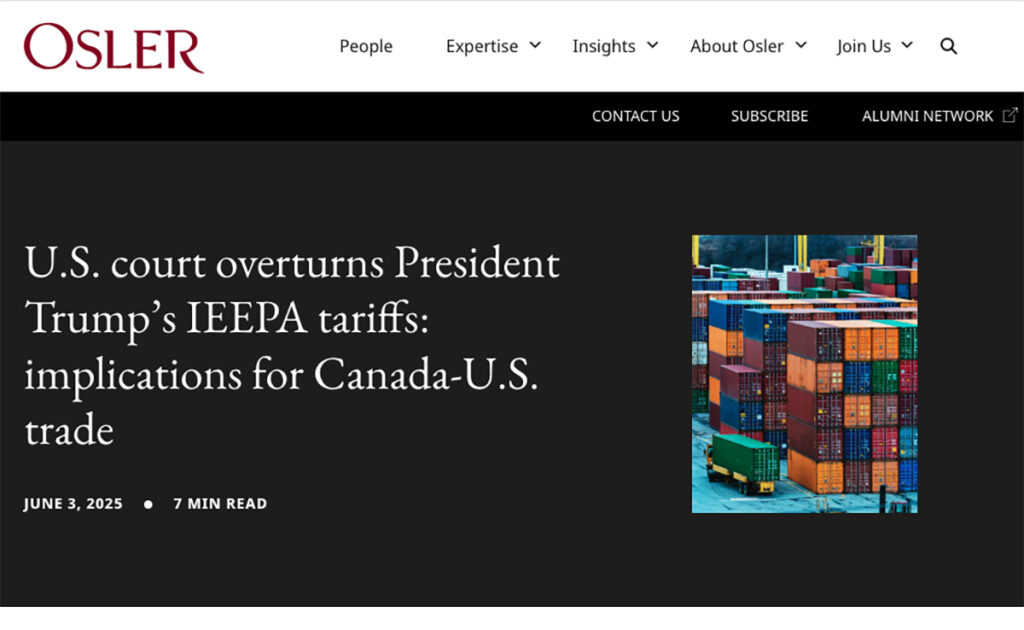Confused by Trump’s tariffs? Better ask a lawyer

WINNIPEG — Keeping track of U.S. tariffs on Canadian goods, including agricultural products, now requires an advanced degree in law or international trade protocols.
Osler, a business law firm with offices in Toronto, Montréal, Calgary, Ottawa, Vancouver and New York, attempted to make sense of the ongoing trade chaos in a June 3 post on its website.
Follow all our tariff coverage here
Read Also


Red lentil supply depends on Canada, Australia
The 2025-26 red lentil market hinges on what happens with Australia and Canada, say analysts.
The online document goes on for pages, summarizing the legal challenges and court decisions in America during late May and early June and the implications for trade between the U.S. and Canada.
The key event happened May 28, when the U.S. Court of International Trade (CIT) overturned the tariffs imposed by U.S. president Donald Trump under the International Emergency Economic Powers Act (IEEPA), Osler said.
“The CIT’s decision covers the so-called ‘fentanyl’ tariffs imposed on … Canada (10 per cent on energy and potash, 25 per cent on all other products) and on Mexico and China, from which (Canada-U.S.-Mexico Agreement)-compliant goods were later excluded. It also covers the global so-called ‘reciprocal’ tariffs announced April 2 (of 10 per cent on all countries),” trade experts with Osler said.
The next day, another U.S. court imposed a temporary stay of that decision, meaning the “fentanyl” tariffs will remain in place until courts can hear the U.S. government appeal.
Adding to the legal confusion, yet another federal court ruled that the “reciprocal” Trump tariffs are unlawful.
The legal decisions don’t restrict Trump’s ability to impose tariffs on steel and aluminum. On May 31, he promptly announced a doubling of tariffs to 50 per cent.
So, what does this all mean for Canadian exporters, including farmers?
It’s likely that the trade chaos will persist, Osler said.
“Given the central role tariffs have played in president Trump’s international trade and policy strategy, regardless of how the (fentanyl) tariff appeals play out, the Trump administration will likely continue to use legal instruments to levy further tariffs on countries and sectors that fall into its crosshairs.”
Greg Valliere, who has followed U.S. policy for decades in Washington, D.C., has a similar take on the situation.
American courts are unlikely to stop Trump and his obsession with tariffs, he said.
“The stunning, head-spinning, mind-boggling trade fiasco will not be resolved quickly. It probably will land in the Supreme Court — and even that may not settle the issue,” wrote Valliere, the chief U.S. policy strategist for AGF Investments, a firm based in Toronto.
Earlier this spring, when the stock market cratered and Trump backed away from massive tariffs on dozens of countries, there was a feeling that the president had changed his mind, Valliere added.
That feeling was fleeting.
“The markets were ecstatic, but Trump’s softening didn’t last long and now he’s preparing for a long fight.”
U.S. companies and some business groups are challenging Trump’s tariffs through legal action. However, trade experts in Canada are watching Republicans in the Senate and House of Representatives to see if they will begin to resist the president’s actions.
“It’s obvious that there’s quite a few people who want to push back against the president’s tariff agenda,” said Michael Harvey, executive director of the Canadian Agri-Food Trade Alliance.
“In the U.S., international trade is supposed to be a congressional power, and Congress has just largely handed that to the president…. You wonder if Congress will start taking that back, at some point.”
Such a response is possible, but it’s also feasible that Trump gets more aggressive with tariffs.
In its analysis, Osler said the Trump administration has used sections 232 and 301 of the Trade Act of 1974 to investigate unfair trade practices and impose tariffs. Trump has used those tools to enact 25 per cent and now 50 per cent tariffs on steel and aluminum imports.
Similar tariffs could be in the works, Osler said.
“The Trump administration also has initiated many new Section 232 investigations that will likely lead to additional tariffs … in the coming weeks and months.”
That includes possible duties on copper, commercial aircraft and jet engines, medium duty and heavy duty trucks and pharmaceuticals.
Source: producer.com


